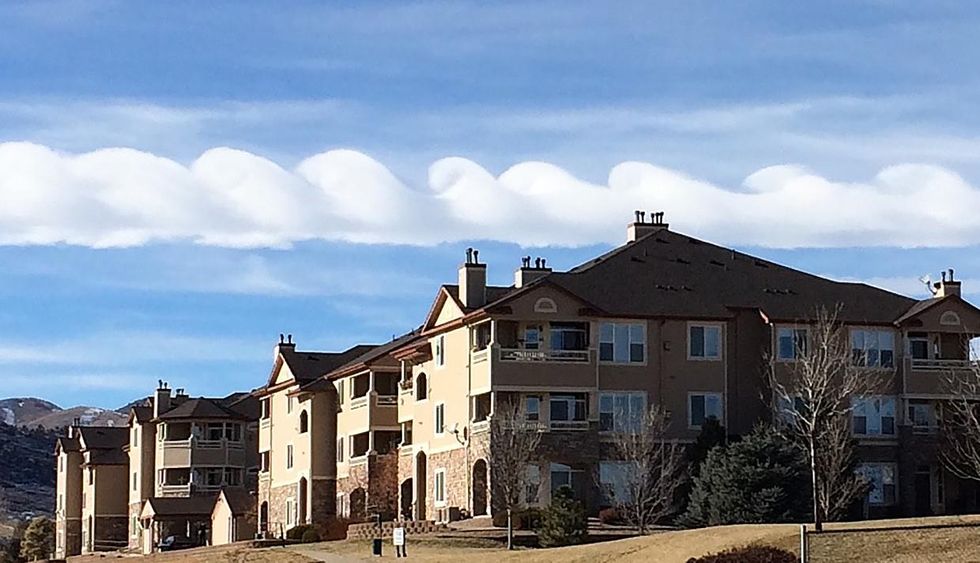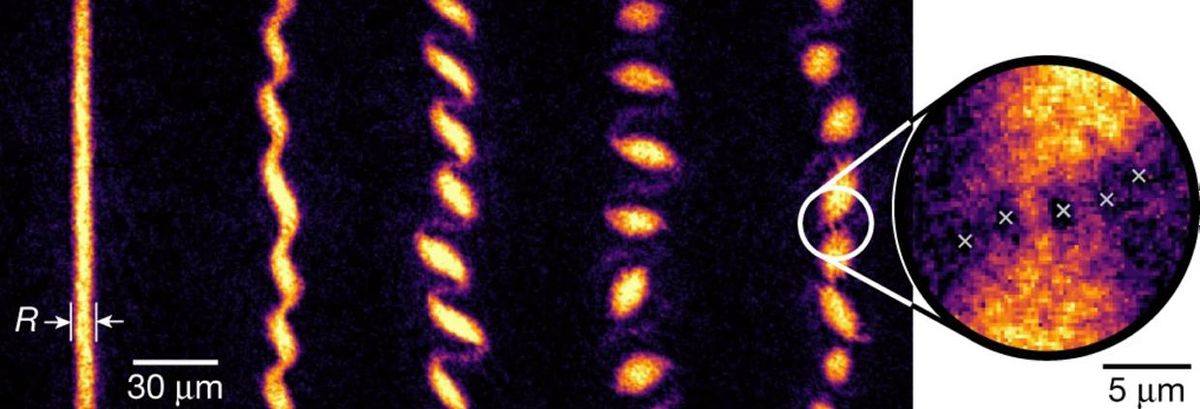Shrink down to the level of atoms and you enter the quantum world, so supremely weird that even a physicist will sometimes gape. Hook that little world to our big, classical one, and a cat can be both alive and dead (sort of).
“If you think you understand quantum mechanics, you don’t understand quantum mechanics,” said the great Richard Feynman, four decades ago. And he knew what he was talking about (sort of).
Now comes a report on a quantum gas, called a Bose-Einstein condensate, which scientists at the Massachusetts Institute of Technology first stretched into a skinny rod, then rotated until it broke up. The result was a series of daughter vortices, each one a mini-me of the mother form.
The research, published in Nature, was conducted by a team of scientists affiliated with the MIT-Harvard Center for Ultracold Atoms and MIT’s Research Laboratory of Electronics.
The rotating quantum clouds, effectively quantum tornadoes, recall phenomena seen in the large-scale, classical world that we are familiar with. One example would be so-called Kelvin-Helmholtz clouds, which look like periodically repeating, serrated cartoon images of waves on the ocean.

The way to make quantum cloud vortices, though, involves more lab equipment and less atmospheric wind shear. “We start with a Bose-Einstein condensate, 1 million sodium atoms that share one and the same quantum-mechanical wave function,”…, says Martin Zwierlein, a professor of physics at MIT.
The same mechanism that confines the gas—an atom trap, made up of laser beams—allows the researchers to squeeze it and then spin it like a propeller. “We know what direction we’re pushing, and we see the gas getting longer,” he says. “The same thing would happen to a drop of water if I were to spin it up in the same way—the drop would elongate while spinning.”
What they actually see is effectively the shadow cast by the sodium atoms as they fluoresce when illuminated by laser light, a technique known as absorption imaging. Successive frames in a movie can be captured by a well-placed CCD camera.
At a particular rotation rate, the gas breaks up into little clouds. “It develops these funny undulations—we call it flaky, then becomes even more extreme. We see how this gas ‘crystalizes’ in a chain of droplets—in the last image there are eight droplets.”
Why settle for a one-dimensional crystal when you can go for two? And in fact the researchers say they have done just that, in as yet unpublished research.
That a rotating quantum gas would break into blobs had been predicted by theory—that is, one could infer that this would happen from earlier theoretical work. “We in the lab didn’t expect this—I was not aware of the paper; we just found it,” Zwierlein says. “It took us a while to figure it out.”
The crystalline form appears clearly in a magnified part of one of the images. Two connections, or bridges, can be seen in the quantum fluid, and instead of the single big hole you’d see in water, the quantum fluid has a whole train of quantized vortices. In a magnified part of the image, the MIT researchers found a number of these little holelike patterns, chained together in regularly repeating fashion.
“It’s similar in what happens when clouds pass each other in the sky,” he says. “An originally homogeneous cloud starts forming successive fingers in the Kelvin-Helmholtz pattern.”
Very pretty, you say, but surely there can be no practical application. Of course there can; the universe is quantum. The research at MIT is funded by DARPA—the Defense Research Advanced Project Agency—which hopes to use a ring of quantum tornadoes as fabulously sensitive rotation sensors.
Today if you’re a submarine lying under the sea, incommunicado, you might want to use a fiber optic gyroscope to detect slight rotational movement. Light travels in both one way and the other in the fiber, and if the entire thing is spinning, you should get an interference pattern. But if you use atoms rather than light, you should be able to do the job better, because atoms are so much slower. Such a quantum-tornado sensor could also measure slight changes in the earth’s rotation, perhaps to see how the core of the earth might be affecting things.
The MIT researchers have gone far down the rabbit hole, but not quite to the bottom of it. Those little daughter tornadoes can be confirmed as still being Bose-Einstein condensates because even the smallest ones still have about 10 atoms apiece. If you could get down to just one per vortex, you’d have the quantum Hall effect, which is a different state of matter. And with two atoms per vortex, you’d get a “fractional quantum Hall” fluid, with each atom “doing its own thing, not sharing a wave function,” Zwierlein says.
The quantum Hall effect is now used to define the ratio of Planck’s constant divided by the charge of the electron squared (h/e2)—a number called the von Klitzing constant—which is about as basic as basic physics gets. But this effect is still not fully understood. Most studies have focused on the behavior of electrons, and the MIT researchers are trying to use sodium atoms as stand-ins, says Zwierlein.
So although they’re not all the way to the bottom of the scale yet, there’s plenty of room for discovery on the way to the bottom. As Feynman also might have said (sort of).
- Quantum Dot Solar Cells Break Conversion Efficiency Record - IEEE ... ›
- Platinum Catalysts Are Outshined By Graphene Quantum Dots ... ›
Philip E. Ross is a senior editor at IEEE Spectrum. His interests include transportation, energy storage, AI, and the economic aspects of technology. He has a master's degree in international affairs from Columbia University and another, in journalism, from the University of Michigan.



